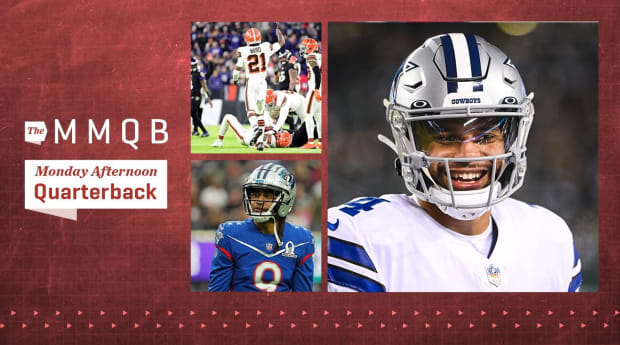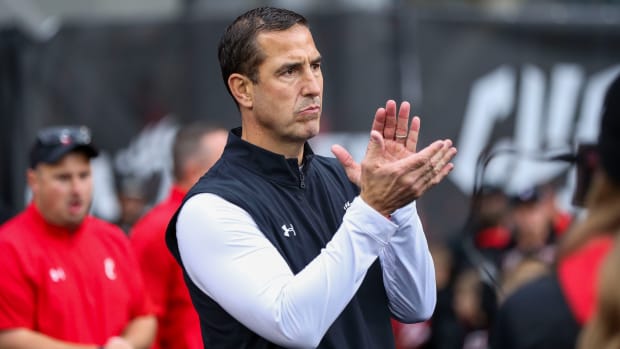Teams’ offseason programs are becoming less of a one-size-fits-all affair. Plus, how Denzel Ward’s deal affects the Browns and other cornerbacks, the turning point in the Colts’ pursuit of Stephon Gilmore and more.
It’s the week before the week …

Prescott: Tommy Gilligan-USA TODAY Sports; Ward: Evan Habeeb/USA TODAY Sports; Gilmore: Kirby Lee-USA TODAY Sports
• Twenty-one of the NFL’s 32 teams kick off their offseason programs this week (only the Bengals won’t be underway by Tuesday morning), and that makes this a good time to check in on the impact last year had on this time of year.
You’ll remember back 11 months ago there was a fight over protocols, and the feel and form of the offseason program between players and their teams. Over time, most worked out agreements for players to come in. The Bucs basically set up two sets of OTAs—one for veterans directed by Tom Brady, and another for young, developmental types led by coaches. The Eagles scrapped all 11-on-11 and 7-on-7 work, and canceled their mandatory minicamp. The Dolphins had players wear flip-flops for walkthroughs.
The idea, in each case, was to take miles off the players’ bodies, and reduce the injury risk that guys would typically face in the spring.
It’s hard to say whether or not it worked, after just one year. But both the Bengals and Rams worked with their players last year, and altered their offseason programs, and made the Super Bowl in the aftermath (conversely, the other two conference finalists, Kansas City and San Francisco, had business-as-usual offseason programs in the spring of 2021). So at the very least, there wasn’t any big immediate detriment.
And thus, this year, there have already been talks, although far less public ones, between players and their teams. The Bengals, after playing a 21-game season, decided to push the start of their program back two weeks—to allow for their coaches to focus on the draft, and give their players a break while hoping to ensure they’ll be locked in when they do come back. The Bills and Colts are two other teams that, I’m told, worked with their players to try and come up with a schedule that worked for everyone.
What’s the upshot of all this? Well, I think it’s good that everyone is looking at these things a little more critically. Also, it’s obvious that while every player may need parts of the offseason program, the needs of a rookie or second-year player aren’t the same as what a 10-year vet might want to get out of it.
So I’d expect, in the coming weeks, to hear more on how teams are evolving the spring, and how it works in the NFL. What I think comes out of it, sooner or later, is something that’s probably more tailored to the needs of individual guys.
• While we’re there, since 21 teams get started this week, and your Twitter timelines are filled with videos of dudes walking through doors, it’s worth reviewing how all of this works, and will work in the coming weeks.
Phase I (two weeks): Players can be in the building for four hours per day, four days a week, and teams can only specify on two of those hours. It’s set up for meetings, and strength and conditioning work—with only strength coaches allowed with players on the field.
Phase II (three weeks): The same rules as Phase I apply, except that coaches are allowed on the field, as is on-field team work, with any offense vs. defense drills (including one-on-ones) forbidden.
Phase III (four weeks): Players are allowed in the building six hours a day, four days a week, with 10 OTA practices (basically normal, non-contact practices) allowed—with a max of three in a week for the first two weeks, and four in a week for the last two weeks. A mandatory minicamp, with separate rules, is also allowed during this period.
Minicamp: Players can be in the building 10 hours per day, with physicals on Monday and practices Tuesday through Thursday. Two practices per day, with one being a walkthrough, are allowed, and capped at a total of three-and-a-half hours.
So soon enough, you’ll see football players running around on football fields.
• While we’re there, I did find what Cowboys TE Dalton Schultz said about Dallas’s Dak Prescott-led passing camps interesting.
“I think it’s super important anytime that you can throw with your quarterback,” Schultz said. “It’s invaluable, I think. You almost can’t get enough of it, and I think that’s where he’s at with his health and everything compared to last year when he was still in rehab. We’ve had ample opportunities to get out on the field, throw with guys and just kind of start that process back up. Yeah, we’re definitely ahead of where we were last year.”
Obviously, it makes you wonder if a second year-back-from-injury bounce is coming from Prescott. But also, it underscores how players can get the work done on their own (as does what Brady did for the Bucs last year), and how sometimes it’s even more meaningful if their quarterback is running the whole thing.
• The Browns getting Denzel Ward inked to a five-year, $100.5 million deal makes a ton of sense—he’s a premium player at a premium position, and the kind of guy a team doesn’t have to think twice about paying—no one thinks he’ll get complacent. It does, however, lock in another piece of the team’s core and will send the team into the season with 10 guys on the roster making eight figures per year.
Those 10 are, in order of their APY (average per year): Deshaun Watson, Myles Garrett, Ward, Amari Cooper, Joel Bitonio, Wyatt Teller, Jack Conklin, Nick Chubb, John Johnson and David Njoku. That’s three offensive linemen, a quarterback, a defensive lineman, a receiver, a tailback, a safety, a tight end and, now, a corner.
That’s a pretty good job of spreading the wealth around the field by Andrew Berry and his crew. And, again, Ward’s a pretty important piece to that puzzle, given his speed and coverage ability to handle any type of receiver, his flexibility in coverage, dependability 1-on-1 outside the numbers, and the ball skills he’s got to make game-changing plays.
• When deals like Ward’s get done, it’s natural to look at who they might affect next, and to me there really is just one name I could come up with. And that’s Jaire Alexander, the Packers star who lost most of last year to injury, and should be a vital piece in Green Bay trying to take the next step after three consecutive 13-win seasons ended in playoff losses.
Getting Alexander, who’s still just 25, locked up also could help the Packers manage their cap situation moving forward too, since as of right now he’s on his lump sum $12.1 million fifth-year option for 2022.

Katie Stratman/USA TODAY Sports
• So a big piece of my story on Desmond Ridder this morning was on his decision to return for a fifth year at Cincinnati after leading the 2020 Bearcats to the Peach Bowl—and a near upset of Georgia when they got there. And when I asked his coach, Luke Fickell, the other day what impact Ridder had on him, he went back to that call his quarterback made two Decembers ago to stay in school.
“There's no doubt, his dedication, his ability to stay and to make the choice to stay, had a big effect on me,” Fickell said. “You sit there and preach to these kids, and then you see them listen and take what you say and then do it. And then all of a sudden, you get put in a similar situation. Those things, for me, have a great impact. So he helps me be a better person and do what I believe is the best thing to do.
“Because we all think what we know is right. And with what we decide to do, based on what all of a sudden in the moment we think is right, it's amazing when a 21, 22-year-old can help remind you of what's the right thing in there.”
Fickell, of course, has passed on overtures from Power 5 schools to stay at Cincinnati (and soon enough, Cincinnati will become a Power 5 school as a result of that).
• Indy should be getting a motivated Stephon Gilmore going into 2022. The five-time Pro Bowler had a sideways 2021, and quietly dealt with a meniscus issue down the stretch with Carolina. But he’s healthy now, and should be able to hit the ground running going into the offseason program and, in a few months, training camp.
We mentioned this morning how much I like the fit, and why I think it could work to extend Gilmore’s career. But I’m told Gilmore’s decision really came down to where he thought he’d have the best chance to get back to the playoffs and compete for another Super Bowl. And along those lines, as big as it was for Gilmore to have defensive teammates like Darius Leonard and DeForest Buckner, the Colts’ trade for Matt Ryan was a turning point for him.
He simply wasn’t going somewhere without a big-time quarterback in place. Which is what got him to make the trip to Indy, where meetings with Chris Ballard, Frank Reich, Gus Bradley and Ron Milus pushed him to make a call to his agents—and tell them to get a deal done.
• The spots that the Niners, Titans, Seahawks, and Commanders are in with Deebo Samuel, A.J. Brown, D.K. Metcalf and Terry McLaurin, respectively, are all examples of how teams might want to be a little more aggressive in getting their stars signed. Three of the four, all but Metcalf, plan to sit out on-field work during the offseason program to protect themselves against injury as they pursue their paydays.
It’s tough to blame them. And it’s easy to see where the divide is here.
In March and April, three receivers—Stefon Diggs, Davante Adams and Tyreek Hill—received deals that averaged over $22 million per over their first three years. Which raises the bar for the aforementioned, much younger quartet, and raises a question we don’t hear asked enough.
Why aren’t teams trying to get their young stars inked at the combine?
To me, if you’re sure about a guy after three years, getting to him as soon as the season ends, and before free agency gooses the numbers, would be smart. And yet, we almost never see it happen, and it leaves teams in the kinds of positions that San Francisco, Tennessee, Seattle and Washington now find themselves in.
• The amount of work the Jaguars have done on offensive linemen ahead of next week has continually come up in my conversations. And one exec raised this question, which I thought was a good one: “I know they tagged Cam Robinson, and everyone thinks that’s a big thing, but if you have a chance to take a really good left tackle with that pick, is that really going to stop you from doing it?”
It's a fair point, with the following implication—Robinson is no Joe Thomas.
• Everyone wanted to know in February 2018 what happened with Malcolm Butler in Super Bowl LII. We’ve heard the story since. But what hasn’t happened? There’s been no explanation from Butler himself. And maybe, in the end, that’s what paved the way for his return to Foxboro.
“I didn't expect to come back to New England," Butler said to New England reporters on a Zoom call Monday. "But one thing I learned, you never burn your bridges down. You handle situations as a man, as a grown-up. If I didn't do that, I don't think I would have an opportunity to come back here.”
I’d say he’s probably right.
More NFL Coverage: